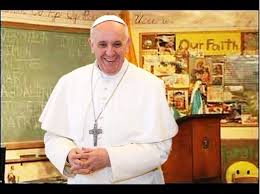 Today in our catechetical series on the commandments, we turn to the Seventh Commandment:
Today in our catechetical series on the commandments, we turn to the Seventh Commandment:
You shall not steal.
But just as the Sixth and Ninth Commandments work together to shape our approach to human sexuality, the Seventh and Tenth Commandments work together to shape our approach to the goods of this world, recognizing that we “cannot love God and money” (Mt. 6:24). The Church isn’t satisfied with our simply not taking what doesn’t belong to us (though that’s a good start!), but wants us to approach worldly goods in a spirit of stewardship and detachment. So we also include here the Tenth Commandment:
You shall not covet your neighbor’s goods.
The Seventh Commandment forbids theft, which is the unjust taking or using of another’s property against the reasonable will of the owner. This can be done also by paying unjust wages, speculating on the value of goods in order to gain an advantage to the detriment of others, or by forging checks or invoices. Other acts forbidden by this commandment include tax evasion, business fraud, willful destruction of private or public property, usury, corruption, the private abuse of common goods, work deliberately done poorly, and waste.
Early in its treatment of the Seventh Commandment, the Catechism talks about the “universal destination of goods,” a principle which acknowledges that God entrusted the earth’s resources to all people. This speaks not only to our sharing resources with others who are less fortunate than we are, but also being good stewards of creation and the earth’s resources for future generations.
At the same time, the Church affirms the right to private property, so long as it’s justly obtained and used. The purpose of private property is to guarantee the freedom and dignity of individual persons by helping them to meet the basic needs of those in their charge and also of others who are in need.
As Vatican II, citing numerous saints and social encyclicals, teaches:
“[M]an should regard the external things that he legitimately possesses not only as his own but also as common in the sense that they should be able to benefit not only him but also others. On the other hand, the right of having a share of earthly goods sufficient for oneself and one’s family belongs to everyone. The Fathers and Doctors of the Church held this opinion, teaching that men are obliged to come to the relief of the poor and to do so not merely out of their superfluous goods” (Gaudium et Spes, no. 69).
One can readily see that the Church finds in this commandment the basis for her rich social teaching, which guides our approach to economic, social, and political life, the right and the duty of human labor, justice and solidarity among nations, and love for the poor. Over the course of 2013, we will survey the various dimensions of the Church’s social teaching in more detail.
The Seventh Commandment requires respect for the goods of others through the practice of justice and charity, temperance and solidarity. In particular it requires respect for promises made and contracts agreed to, reparation for injustice committed and restitution of stolen goods, and respect for the integrity of creation by the prudent and moderate use of the mineral, vegetable, and animal resources of the universe with special attention to those species that are in danger of extinction (Compendium of the Catechism of the Catholic Church, no. 506).
The Lord truly does hear the cry of the poor and identifies with them. The spiritual and corporal works of mercy and the many charitable institutions formed throughout the centuries are a concrete witness to the preferential love for the poor which characterizes Christian disciples (Compendium, no. 520). We need look no farther than Blessed Teresa of Calcutta for evidence that we are called to love the hidden Jesus in the poorest of the poor (cf. Mt. 25:31-46).
As we interiorize the Seventh Commandment, we come to see Our Lord as our treasure, and we hear the call to abandon ourselves to His providential care. The Tenth Commandment continues this work upon our heart, as it calls us in particular to work against the vices of avarice and envy.
Avarice involves an excessive, disordered desire for riches and power. In other words, we “covet” our neighbor’s good and may go to the extreme of unjustly taking these goods for ourselves.
Envy, meanwhile, involves sadness at another’s goods and the immoderate desire to acquire them for ourselves by whatever means we can.
We combat these vices of avarice and envy–and thus observe the Tenth Commandment–by fostering in ourselves a spirit of goodwill and humility, and by rejoicing in other’s blessings.
For more on these commandments, check out Catechism, nos. 2401-63 (Seventh Commandment) and nos. 2534-57 (Tenth Commandment).
Tags: animals, catechesis, Catechism of the Catholic Church, Commandments, creation, environment, poor, social justice, vice, work, Year of Faith
 “The more things change, the more they stay the same.”
“The more things change, the more they stay the same.”








